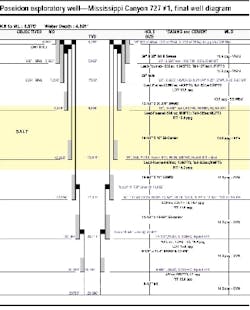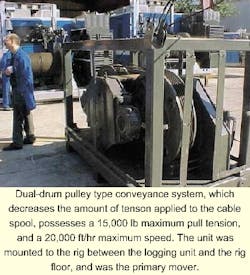DRILLING TECHNOLOGY: PART I: Poseidon 29,000-ft well in 4,800-ft depths harbinger of future for US Gulf
Scott McLeod
Chevron USA
Frank J. Hartley
Drilling/Production Editor
PART I: This is Part I of a two-part series on deep drilling in the US Gulf of Mexico, focusing on the safety regime and equipment used to ensure achievement of target depths. Part II, appearing next month, will focus on the lessons learned from the drilling program.
Oil and gas producers in the US Gulf of Mexico long ago drilled up the shallow seismically visible deposits on the continental shelf and within the last decade accessed the large deepwater reserves on the slopes and fans. This left the more-difficult-to-access reserves in ultra-deepwater and deep under the seafloor.
The challenges, both economic and technical, are manifold for ultra-deepwater reserves. Less well known are the challenges in pursuing very deep reserves - wells in excess of 15,000-18,000 ft vertical depth.
Unlike shallow reserves in shallow and deepwater, seismologists had difficulty imaging deep reserves in the Gulf of Mexico. Salt tabs littered the vertical landscape, obscuring deeper deposits, and deep seismic reflections weren't reliable enough to warrant the cost of drilling a costly deep well.
Only lately have seismologists been able to reliably model deep sedimentary zones, especially those beneath salt bodies. This allows producers then to focus on how to trim deep drilling costs to make the pursuit of deep oil and gas commercially acceptable. On board with the difficulty also is the US Minerals Management Service, charged with making the pursuit of US deep reserves worthwhile for producers.
Record well
In the past, few wells in the US Gulf of Mexico surpassed 20,000 ft. Chevron USA, which continues the search for oil and gas in deepwater, is turning attention to a focused search in deep sediments. The most recent major effort in that area is the company's Poseidon Prospect, Mississippi Canyon 727 #1 well, which was recently drilled to 29,750 ft (with a TVD or true vertical depth of 29,680 ft). The semisubmersible Transocean Marianas #1 drilled the deep hole in 4,800 ft water depths, a challenging water depth to even consider for a challenging target. The initial well program was for 28,100 ft MD (measured depth), with approval to go to 30,000 ft TD (total depth). Well planners decided to let the geology determine the TD point.
The well, drilled over a period of 166-1/2 days, is now complete. Such a well requires the right equipment and procedures to match, but also the right people. The following is a summary of the Poseidon challenges and solutions:
- Safety and action plan: The operators prepared a safety and compliance action plan specific to Poseidon operations working with Transocean to ensure that it fit well with the contractor's START (See, Think, Act, Reinforce, Track) program on the rig. The two programs were combined prior to spud to ensure there would be no gaps between to the programs. A Chevron environmental and safety (E&S) specialist was added to Chevron's rigsite crew to assit drilling supervisors and Transocean's safety personnel with the application of the two programs. The result was incident-free operations (IFO), and no E&S or compliance incidents for the well. No INCs were issued during five MMS inspections.
- Shallow hazards events: Shallow hazards investigation at the drilling location indicated a significant chance for a shallow hazard event prior to reaching the top of the salt. A specific plan that included an additional casing string, kill mud, and real-time hazard prediction was developed. An additional string of 28-in. conductor was added to assist with keeping the heavy mud in the well, if kill mud was required. The rig had over 20,000 bbl of kill mud available on location to use in combination with a dynamic mud mixer that would allow the mud weight needed for the well to be adjusted between 11-15 ppg on the fly, as required.
- Shallow flow plan: A shallow flow plan was developed so that all members of the crew knew their job in the event of a shallow water flow in order to minimize the time required to begin kill operations. A Chevron shallow hazards team member was at the wellsite reviewing logging-while-drilling (LWD) logs to assist with predicting hazards zones. In drilling the well, the hazardous zone was picked within 40 ft, and the well had a extremely strong shallow water flow. The flow plan was implemented within minutes of identifying the flow, and the well was killed and drilling operations continued within 1 hour of detection.
- Equipment inspection: A well of this magnitude cannot support poor equipment preparation or condition, so Chevron worked with Transocean and the service contractors to plan and execute detailed inspections of rig equipment, bottomhole assembly (BHA), drillpipe, and casing tools to ensure that top quality fit-for-propose equipment was used on the well. This resulted in no drillpipe failures of any type, no BHA failures or fishing operations during the well.
- Execution Planning: Chevron used there "Get Smart" well planning and engineering program during the planning and execution of the well. Input was acquired from Transocean and the service contractors to assist with making the drilling plans fit the well requirements. This helped make sure that all parties were aware of the near and long term plans for the well. This effort resulted in much more efficient and safe rig operations during all phases of the well. The "GetSmart" program was also used to record all lessons learned during the drilling operations for use on future Poseidon wells or to be passed on the other Chevron operations.
- Casing points: Execution to the 18 in. casing point in salt was excellent. There were many obstacles, new operations and equipment, shallow flow hazards. An immense quantity of equipment and materials was managed very well.
- Subsea Wellhead: The casing design required to meet the wells objectives necessitated the use of a subsea wellhead system that would facilitate an extra casing string to be hung in the wellhead. The Dril-Quip's Big-Bore Subsea Wellhead system was chosen to meet this requirement and was installed successfully, and all of the components worked as designed.
- Team building: Because Chevron was using a rig (the Transocean Marianas) new to Chevron, in addition to a very difficult well, a detailed pre-spud meeting was held to outline the safety and complience requirements, drilling challenges and form a team. All of the companies involved had input into the well plan. The result was a performance that included less than 2% rig downtime, 2% service company trouble time and IFO operations.
- Rig performance: The drilling unit Transocean Marianas was a major reason for the well's success, in that the people and equipment performed at or above all expectations.
- Drillstring design: Design of the drillstring for the well was challenging in terms of tension capability and hydraulics. The drillstring had to run two long strings, with weights up to 1.1 million lb, and several liners with combined liner-drillstring weight in excess of 900,000 lb. Hole-cleaning hydraulics had to be kept to an optimum in order to accommodate the high penetration rates expected. For tension capacity, the rig used a combination of the Marianas' 5 1/2-in. drill pipe and a string of 5 1/2 in. 38 ppf, S-135 pipe used during all the heavy loads. To assist with the wellbore hydraulics, a riser length of 6 5/8 in. drill pipe was used during the early stages of the well when high flow rates were critical. Chevron teamed with Shell and Transocean to add a fourth mud pump to the rig to assist with hydraulics needs.
- HT/HP pressure logging: One of the deliverables for the well was logging-while-drilling (LWD) logs. Chevron worked with Schlumberger to assist with this requirement, although the team was only partially s
Equipment, mud, supplies, personnel, and events handled during the drilling of the record-depth well
- Casing installed amounted to eight sizes with a total length of 38,770 ft
- Total joints run was 959
- Total air weight of the casing installed was 4,150,700 lb.
- 120 boats were loaded and unloaded
- Casing unloaded or returned to boats totaled 43,000 ft at a weight of about 4,500,000 lb
- Cement transferred to the rig was 18,000 sacks
- Barite transferred to the rig totaled 110,600 sacks
- Bulk gel transfered to the rig totaled 3,100 sacks
- Water-base mud and brine transferred to the rig totaled 33,730 bbl
- Joints of riser run and laid down totaled 320
- Over 250 helicopter flights handled during drilling operations
- Over 250,000 manhours worked incident free


